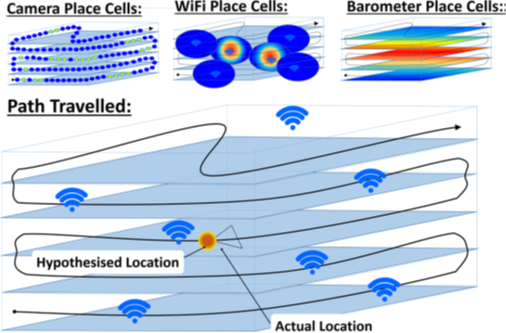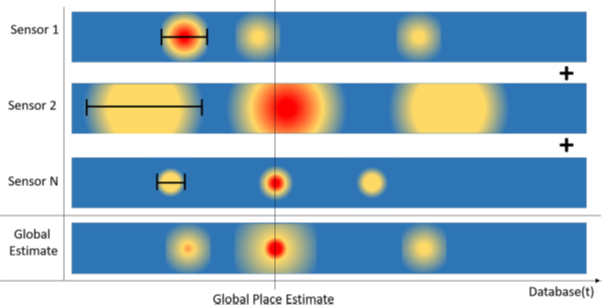
How to perform robot place recognition with multi-scale, multi-sensor system inspired by place cells?
Adam Jacobson, Zetao Chen, Michael Milford. Leveraging variable sensor spatial acuity with a homogeneous, multi-scale place recognition framework. Biological Cybernetics, Jan 20, 2018, https://doi.org/10.1007/s00422-017-0745-7 .
This paper presented a biologically inspired multi-scale, multi-sensor place recognition system that incorporates the varying spatial localization estimates provided by different sensing modalities to improve overall place recognition performance. They focused on developing a model of place cells discovered within the rodent hippocampus, incorporating the multi-scale, multi-sensory nature of the place cells into our robotic localization model.
Keywords: Place recognition, Place Cells, Sensor fusion, Robotics
Some main contributions as follows:
- The researchers develop a localization system for integrating commodity sensors, such as camera, Wi-Fi and barometric sensors, which naturally produce localization results of different spatial resolution with a multi-scale homogeneous mapping framework.
- The proposed framework encodes the sensory data associated with places at several different scales and then performs recognition over these multiple scales before combining the individual scale place match hypotheses to form a global place match hypothesis.
- They provide an analysis of the multi-scale framework, capturing each sensor’s contribution to place estimation and evaluating each sensor’s optimal operating scale.

Fig. 1 Illustration of multi-scale, multi-sensor fusion for place recognition within a multi-story building.

Fig. 2 Example of the spatially specific place cells firing as a rodent runs down a linear track.

A framework to combine sensors with variable place resolutions.
For further more info, please read the paper.
About
Brain Inspired Navigation Blog
New discovery worth spreading on brain-inspired navigation in neurorobotics and neuroscience
Recent Posts
- How locomotor development shapes hippocampal spatial coding?
- How human, animals, robots encode and recall place?
- How the brain constructs time and space and how these are related to episodic memory?
- How environmental novelty modulate rapid cortical plasticity during navigation?
- How the Hippocampal Cognitive Map Supports Flexible Navigation?
Tags
Categories
- 3D Movement
- 3D Navigation
- 3D Path Integration
- 3D Perception
- 3D SLAM
- 3D Spatial Representation
- AI Navigation
- Bio-Inspired Robotics
- Brain Inspired Localization
- Brain-Inspired Navigation
- Cognitive Map
- Cognitive Navigation
- Episodic Memory
- Excerpt Notes
- Flying Vehicle Navigation
- Goal Representation
- Insect Navigation
- Learning to Navigate
- Memory
- Neural Basis of Navigation
- Path Integration
- Path Planning
- Project
- Research Tips
- Robotic Vision
- Self-Flying Vehicles
- Semantic Memory
- Spatial Cognition
- Spatial Cognitive Computing
- Spatial Coordinate System
- Spatial Learning
- Spatial Memory
- Spatial Resoning
- Time
- Unclassified
- Visual Cortex
- Visual Cue Cells
Links
- Laboratory of Nachum Ulanovsky
- Jeffery Lab
- BatLab
- The NeuroBat Lab
- Taube Lab
- Laurens Group
- Romani Lab
- Moser Group
- O’Keefe Group
- DoellerLab
- MilfordRobotics Group
- The Space and Memory group
- Angelaki Lab
- Spatial Cognition Lab
- McNaughton Lab
- Conradt Group
- The Fiete Lab
- The Cacucci Lab
- The Burak Lab
- Knierim Lab
- Clark Spatial Navigation & Memory Lab
- Computational Memory Lab
- The Dombeck Lab
- Zugaro Lab
- Insect Robotics Group
- The Nagel Lab
- Basu Lab
- Spatial Perception and Memory lab
- The Neuroecology lab
- The Nagel Lab
- Neural Modeling and Interface Lab
- Memory and Navigation Circuits Group
- Neural Circuits and Memory Lab
- The lab of Arseny Finkelstein
- The Epstein Lab
- The Theoretical Neuroscience Lab
- Gu Lab (Spatial Navigation and Memory)
- Fisher Lab (Neural Circuits for Navigation)
- The Alexander Lab (Spatial Cognition and Memory)
- Harvey Lab (Neural Circuits for Navigation)
- Buzsáki Lab
- Brain Computation & Behavior Lab
- ……